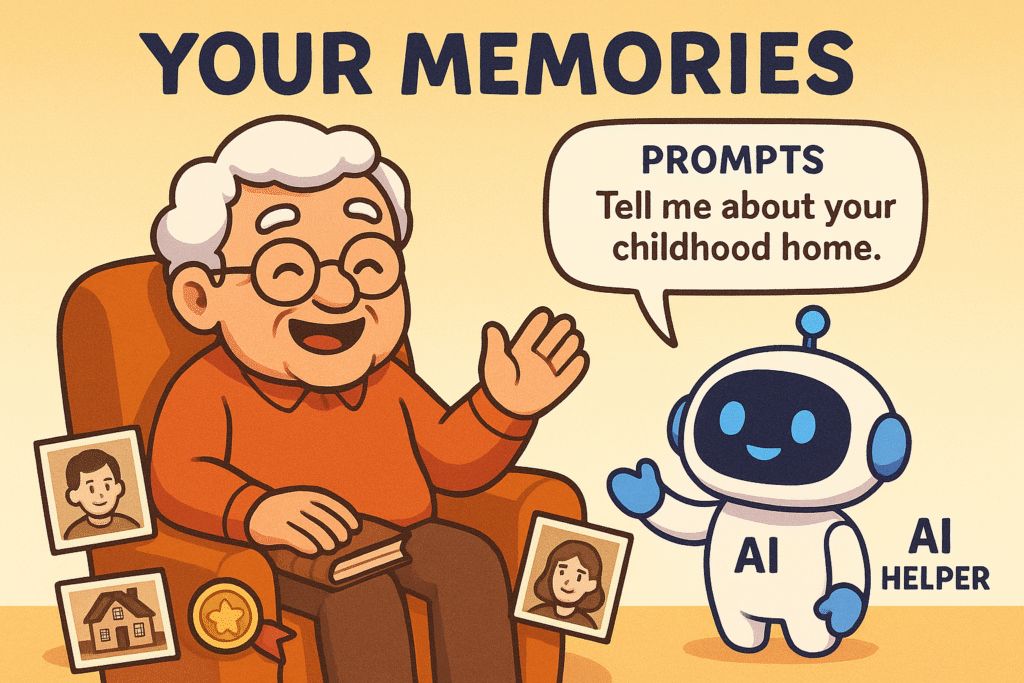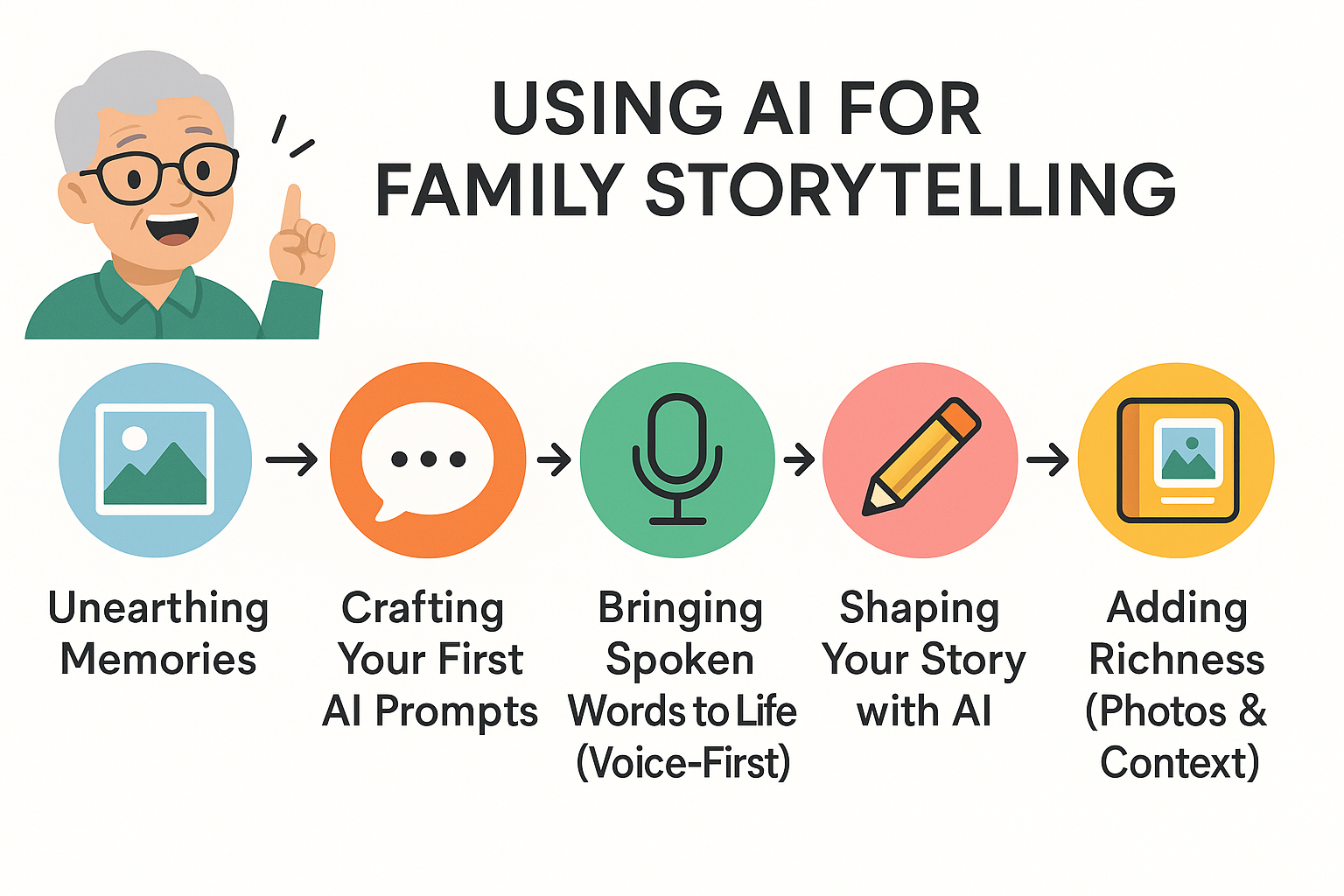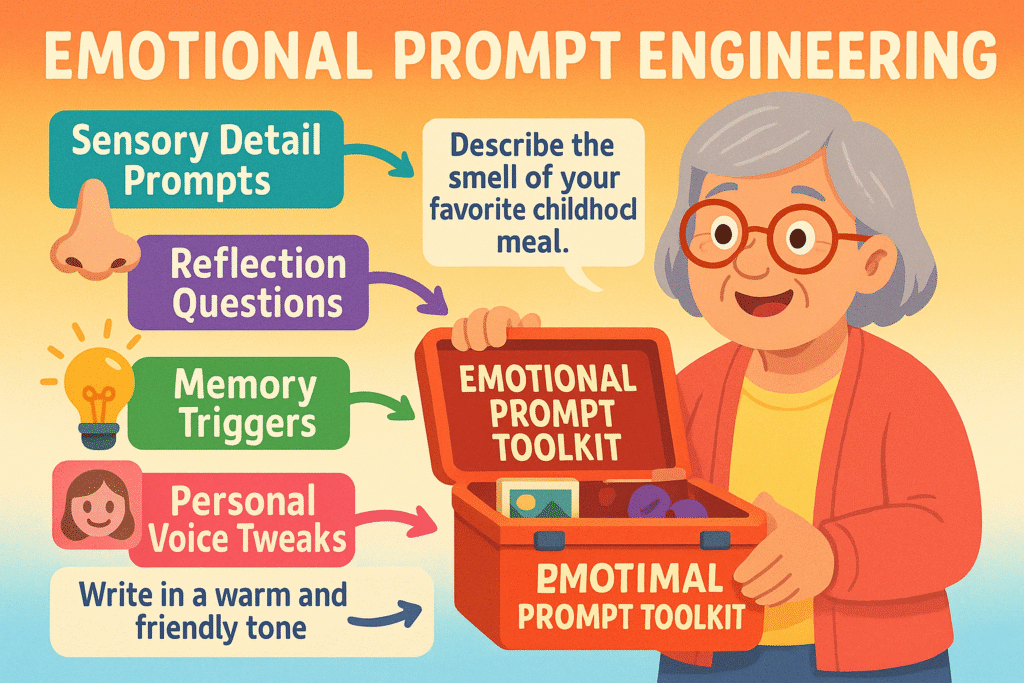
Newsletter Subscribe
Enter your email address below and subscribe to our newsletter


Have you ever tried to write down a family story? You sit down, armed with a fresh cup of coffee and the noble intention of preserving your legacy for generations to come.
You stare at the blinking cursor on the blank white screen, which seems to be blinking, “Well? We’re waiting!” in Morse code.
Your mind, which five minutes ago was a bustling Grand Central Station of vivid memories, suddenly becomes a dusty, abandoned train depot.
The story about your first car, the one with the questionable brakes and a radio that only played polka music, has vanished.
The memory of your grandmother’s legendary apple pie recipe? Gone.
It’s like your brain has a security guard that yells, “Nothing to see here, folks!” the moment you try to write.
If this sounds familiar, you’re not just getting older; you’re human.
Staring at a blank page is intimidating for everyone, from professional novelists to people just trying to explain why Uncle Earl was banned from Thanksgiving in ‘78.
But what if you had a friendly assistant, one who could gently nudge your memory with the perfect question at the perfect time?
That’s where the creative side of Artificial Intelligence, or AIArtificial Intelligence (AI) is basically when computers get smart—really smart. Imagine if your c... More, comes in. And before you picture a scary robot from a science fiction movie, think of it less as a machine and more as a patient, tireless conversation partner who is fantastic at helping you find the right words.
Let’s get one thing straight: AI is not here to write your story for you.
Your memories, your voice, and your unique perspective are the magic ingredients. Think of AI as your personal storytelling sous-chef. You’re still the master chef; the AI just chops the onions so you don’t have to cry over the keyboard.
In simple terms, an AI tool like ChatGPT is a computer program you can have a conversation with. You ask it questions—called “prompts”—and it gives you answers.
For family storytelling, this is revolutionary. Instead of facing a blank page, you can ask the AI, “Can you give me some questions to help me remember my first day of school?“
Suddenly, you’re not alone anymore. The AI might respond with prompts like:
See? It’s not writing your memory. It’s handing you the keys to unlock it.
It’s a tool to kickstart your brain and get the stories flowing, turning the daunting task of “writing your memoir” into a fun chat about your life.

Ready to give it a whirl? Think of this as a simple recipe for turning your memories into written treasures. There’s no pressure, no deadlines, and you can’t mess it up.

Before you even talk to an AI, jog your own memory. Pull out an old photo album, play a song from your teenage years, or just think about a favorite family holiday.
Pick one memory that makes you smile. Don’t worry about the whole life story; just start with one small, happy moment.
Now, let’s talk to your new assistant. Go to a free AI tool and type in a simple request. The key is to ask for questions.
Beginner-Friendly PromptA prompt is the message or question you type in to tell an AI like ChatGPT what you want it to do. I... More Examples:
The AI will give you a list of thought-starters, instantly defeating the dreaded blank page.
For many of us, talking is a whole lot easier than typing. Here’s a secret weapon: your phone! Use the voice recorder app to just talk about a memory. Tell the story as if you were talking to a grandchild.
Once you have the recording, you can use free AI transcription tools to turn your spoken words into text. It won’t be perfect, but it gives you a written draft without ever having to type a word. From there, you can clean it up and add more detail.
Once you have a rough draft (either typed or from a recording), the AI can help you organize it. You can copy and paste your messy paragraph and ask for help.
Helpful Organizing Prompts:
It’s like having an editor who is available 24/7 and works for free.
This is where it gets really fun. Let’s say you’re writing about a family trip from 1965. You can ask the AI, “What were some popular songs and movies in the summer of 1965?” This adds wonderful, vivid detail to your story that brings the era to life for younger generations.
Once you’re comfortable, you can start asking the AI more specific, powerful questions. The difference between a good story and a great one is detail—especially the kind that tickles the senses. This is where you can guide the AI to help you dig deeper.
Instead of a general prompt like, “Help me remember my childhood home,” try getting specific. This is what we call “Emotional Prompt Engineering”—a fancy term for asking questions that get to the heart of a memory.

Try these types of prompts to unlock richer details:
By guiding the AI to ask about senses and feelings, you’re not just recalling facts; you’re reliving moments. This is how your stories become vibrant, captivating treasures that let your family truly understand your life.
It’s perfectly normal to have questions. After all, this is new territory. Let’s tackle some of the most common ones.
Absolutely! Think of it like using a calculator for math or a GPSThe Global Positioning System (GPS) is a technology that uses satellites in space to find your locat... More for directions. It’s a tool that helps with the heavy lifting so you can focus on what’s important: the story itself. It’s not “cheating”—it’s working smarter.
This is one of its greatest strengths. AI is fantastic at helping you find the thread. You can give it a collection of disconnected memories, and ask, “Can you help me see a theme here, or suggest a way to structure these stories?” It can act as an organizer for a lifetime of scattered thoughts.
This is an excellent and important question. AI can sometimes “hallucinate,” which is a techy way of saying it invents details. Your job is to be the editor-in-chief. Always read what the AI generates and treat it as a suggestion, not a fact. If it adds a detail that wasn’t there, simply delete it. You are the final authority on your own life.
The key is to use the AI for ideas and structure, not final wording. Take its suggestions, then rewrite them in your own words. Read it aloud. Does it sound like something you would say? If not, tweak it until it does. Your voice is the heart of the story; the AI is just the pacemaker that keeps it going.
This is a smart concern. It’s best to avoid inputting highly sensitive personal information, like Social Security numbers, bank details, or specific medical information, into any public AI tool. When writing your stories, you can use general terms or change names if you’re discussing sensitive family matters.
The most important thing you can leave behind isn’t money or property—it’s your stories. They are the threads that connect generations, the lessons learned, the laughter shared, and the love that defined a family. For too long, the technical challenge of writing has been a barrier for too many.
AI offers a bridge over that barrier. It’s a friendly, patient tool that can help you overcome writer’s block, organize your thoughts, and finally get those precious memories down on paper.
So go ahead. Open up a free AI tool, and ask it one simple question about one happy memory. You might be amazed at the stories that come pouring out.